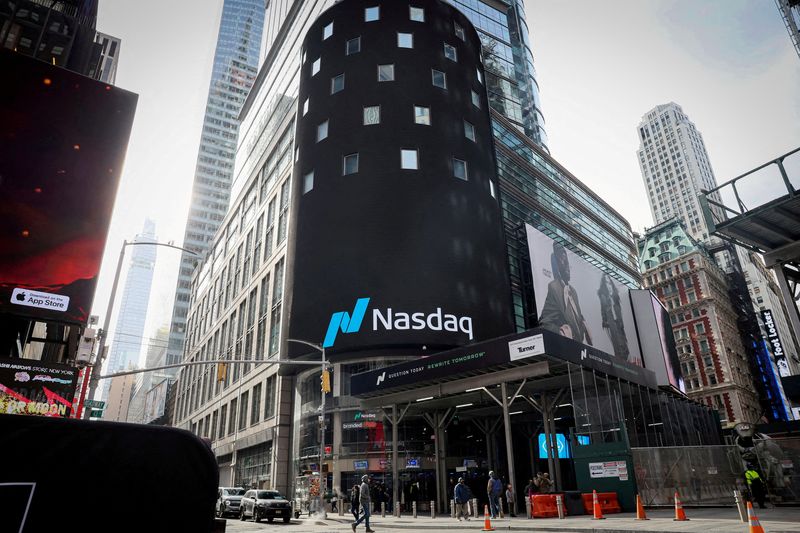By Sinéad Carew and Lisa Pauline Mattackal
(Reuters) -Wall Street’s main indexes closed lower on Friday, with the S&P 500 and Nasdaq notching their biggest one-day losses in two weeks, on concerns about slower interest-rate cuts and as investors reacted to cabinet picks by U.S. President-elect Donald Trump.
Federal Reserve Chair Jerome Powell on Thursday cited ongoing economic growth, a solid job market, and inflation above the U.S. central bank’s 2% target as reasons it can afford to be careful with the pace and scope of future rate cuts.
Traders increased bets the Fed will not change rates at its December meeting, pricing in a roughly 42% chance, versus roughly 14% a month ago, according to the CME FedWatch tool. They also dialed back expectations for easing in 2025.
This view was reinforced by Friday’s economic data showing U.S. retail sales rose slightly more than expected in October. Import prices also rebounded and data released on Wednesday and Thursday showed sticky inflation.
“In the last 48 hours we’ve had some pretty big changes, not just from the election but from economic data that was better than expected and Powell speaking about not having to be as aggressive on interest rate cuts,” said Adam Rich, deputy chief investment officer for Vaughan Nelson in Houston.
“Market expectations for interest rate cuts have come down materially and also the market is readjusting after a pretty bullish reaction to the U.S. election.”
Friday’s sell-off ended a week in which market focus shifted from the U.S. election win by Trump, seen as a pro-business choice, to worries about the rate cut path and potential inflation risks under the next administration.
For the week, the S&P 500 fell 2.08% while the Nasdaq declined 3.15%, marking their biggest weekly losses in more than two months. The Dow fell 1.24% for the week.
“Volumes are elevated today. People are taking profits because this has been a good month. U.S. stocks have been doing well this month. But it’s not blanket profit taking,” said John Augustine, chief investment officer at Huntington National Bank, pointing to gains in the Utilities sector. “This suggests more of a rotation.”
Stocks of vaccine makers and packaged food companies also dipped after Trump said he would nominate Robert F Kennedy Jr, who has spread misinformation on vaccines and criticized ultra-processed foods, to head the Department of Health and Human Services.
The Dow Jones Industrial Average fell 305.87 points, or 0.70%, to 43,444.99, the S&P 500 lost 78.55 points, or 1.32%, to 5,870.62 and the Nasdaq Composite dropped 427.53 points, or 2.24%, to 18,680.12.
The small-cap Russell 2000 index ended down 1.4%, its fourth consecutive session of losses.
Shares of defense firms and government contractors also fell, partly on concerns about Trump’s picks earlier this week to head a new Department of Government Efficiency.
Among the S&P 500’s 11 major industry sectors information technology was the day’s biggest loser, dropping 2.5%.
Also, the Philadelphia SE Semiconductor index fell 3.4% with Applied Materials (NASDAQ:AMAT) tumbling 9.2% after the U.S. maker of chip-manufacturing equipment forecast first-quarter revenue below Wall Street estimates.
Shares in Moderna (NASDAQ:MRNA) dropped 7.3% and Pfizer (NYSE:PFE) fell 4.7%, weighing on healthcare, which closed down 1.88% after hitting its lowest since May in its fifth straight day of declines.
The Consumer staples index, which finished off 0.8%, was also hurt by the nomination news. Among its biggest decliners, Monster Beverage (NASDAQ:MNST) fell 7%, Lamb Weston lost 6% and Keurig Dr Pepper (NASDAQ:KDP) dropped 5% to its lowest level since April.
Adding to Friday’s volatility was the regular expiration of stock and index options, according to Vaughan Nelson’s Rich.
Brent Kochuba, founder of financial insights company SpotGamma, said Friday’s stock market weakness was partly due to investors being ill-prepared for a pullback.
CBOE’s volatility index, also known as Wall Street’s fear gauge, hit 17.55 earlier on Friday, the highest since Election Day on Nov. 5. However the index pared gains to close at 16.14.
Declining issues outnumbered advancers by a 1.89-to-1 ratio on the NYSE where there were 117 new highs and 108 new lows.

On the Nasdaq, 1,241 stocks rose and 3,115 fell as declining issues outnumbered advancers by a 2.51-to-1 ratio. The S&P 500 posted 13 new 52-week highs and 25 new lows while the Nasdaq Composite recorded 36 new highs and 285 new lows.
On U.S. exchanges 15.47 billion shares changed hands compared with the 13.94 billion average for the last 20 sessions.






